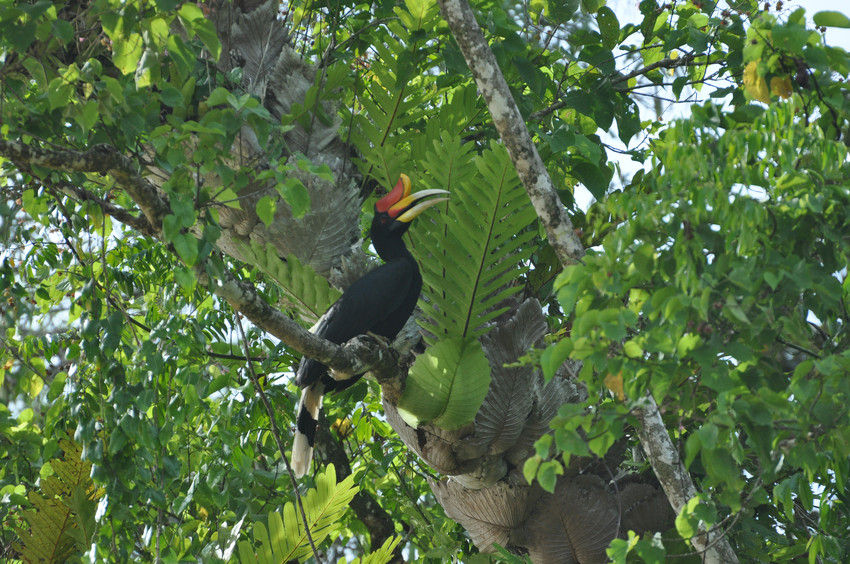

The feathers are used for traditional costumes or some kind of ornaments to be hung on a warrior’s weapon such as spear, blowpipe, wooden shield and machete. When offered for sacrifice, its yellow-orange beak slightly curved out shape is taken out, and when carved and worn as a necklace, possesses the power to “control other people.” The Rhinoceros Hornbill population especially is under a cloud, being a much sought after hunting and poaching target.Īccording to native folklore, this species holds mythical powers. It seems the hornbill is on borrowed time with hunting and habitat loss posing as major threats to a potential wipeout of this particular avian species, not only in Sarawak but also other parts of the world such as Thailand, Indonesia, India, Africa and the Philippines. Middlemen buy them for between 1 million rupiah (US$105) and 3 million rupiah apiece while the price can escalate on the international market, the report said. The casques, bound for China, are processed into objects of art such as sword handles and other items. As many as 285 bills from enggang gading (Helmeted Hornbill) were confiscated in smuggling attempts foiled by the Natural Resources Conservation Center (BKSDA) of West Kalimantan.ĭescribing the seizure as “unusually large,” the Centre said this had, without doubt, resulted in a reduction of the male hornbill population in the area. The Jakarta Post (November 2012) reported that hornbill body parts had been smuggled out of Kalimantan, Indonesia. Moreover, hornbills are reportedly also hunted for food.

Widespread logging and poaching are allegedly threatening to push some of the popular species to the brink of extinction in the forests of Borneo. Today, it still enjoys the exalted status as the Sarawak state emblem.īut is Sarawak still truly the Land of Hornbills? The Rhinoceros Hornbill is noted for the loud ‘whooshing’ sound of its huge wings and the rasping harshness of its haunting call. For some Dayaks, especially the Ibans, the hornbill represents the chief of worldly birds or the supreme worldly bird, and its statue is used to welcome Sengalang Burong, the god of the augural birds, to the feast and celebration of humankind. The Rhinoceros Hornbill is the state bird of Sarawak. It’s found in lowlands and montane, tropical and subtropical regions, and mountain rainforests up to an altitude of 1,400 metres in Borneo, Sumatra, Java, the Malay Peninsula, Singapore and southern Thailand.

The Black Hornbill is the most common while the Rhinoceros Hornbill is the largest of the bucerotidae family in Sarawak.Īn adult Rhinoceros Hornbill is about the size of a swan – 91-122 cm long and weighing two to three kilogrammes. Sarawak is known as the Land of Hornbills because these birds can be found in most parts of the state. The two species found in the peninsula are Plain Pouch and Great Hornbills while the eight indigenous to Sarawak are Oriental-pied Hornbill (anthracoceros albirostris), Black Hornbill (anthracoceros malayanus), Bushy-crested Hornbill (anorrhinus galeritus), White-crowned (crested) Hornbill (berenicornis comatus), Rhinoceros Hornbill (buceros rhinoceros), Helmeted Hornbill (Rhinoplax vigil), Wrinkled Hornbill (aceros corrugatus) and wreathed Hornbill (aceros undulatus). There are 10 hornbill species in Malaysia, eight of which are found in Sarawak, according to Sarawak Forestry Corporation (SFC). I had seen a hornbill – possibly from the Oriental-pied species – flying above Logan Bunut Lake in Lawas while I was making a boat tour around the lake in 2010.Īctually, it’s not uncommon to find hornbills in the forests or see them winging across the land in search of food or back to roost in the hollowed out part of a tree trunk. Females and males often have different coloured faces and eyes. This contrasts with the brightly coloured necks, faces, bills, and casques in many species. Hornbills have long tails, broad wings and white and black, brown, or gray feathers. You can easily pick out hornbills from other birds by a special body part atop their bill called casque. They range from the size of a pigeon to a large bird with a 1.8m wingspan. HORNBILLS (bucerotidae) have many ornithological admirers – with their long eyelashes (modified feathers), dark eyes and an almost comically large, curved bill. The Rhinoceros hornbill enjoys an exalted status as the Sarawak state emblem.


 0 kommentar(er)
0 kommentar(er)
